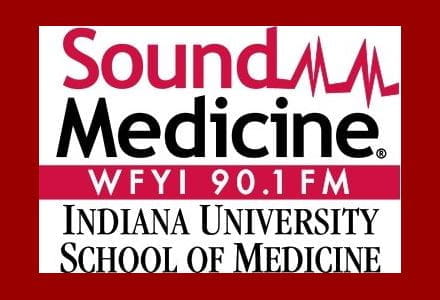INDIANAPOLIS — The “Sound Medicine” program for May 25 revisits reports on cutting-edge surgery, including segments about the complexity of facial transplants, removing tumors through the nose, and alternatives to Mohs surgery for basal cell carcinoma.
How have facial transplants changed since 2008? Daniel Alam, M.D., a facial plastic surgeon at the Cleveland Clinic, performed the first U.S. near-total facial transplant in 2008. Since then, new and promising data has emerged that supports the value and effectiveness of facial transplants. Dr. Alam joins host Barbara Lewis to discuss how things have changed over the past few years, and the promising advances on near-total facial transplants.
How can surgeons remove brain tumors through the nose? Aaron Cohen-Gadol, M.D, visits “Sound Medicine” to discuss performing surgery through the nose. Surgeons across the country are now exploring doing surgeries through existing bodily openings to reduce risk, recovery time and scarring. Dr. Cohen-Gadol discusses accessing the brain through the nose, what type of procedures he is able to perform through natural openings, and the future of this type of procedure. He is an assistant professor of neurological surgery at the Indiana University School of Medicine and a neurosurgeon at Goodman Campbell Brain and Spine in Indianapolis.
Is there a safe alternative to Mohs surgery for skin cancer? Mohs surgery, also known as micrographic surgery, has been the most effective treatment for basal cell carcinoma since its development in 1938. However, Ray Jalian, M.D., a clinical fellow in dermatology at Massachusetts General Hospital, recently led a study that showed lasers to be a promising alternative therapy to remove based cell carcinoma. Dr. Jalian joins “Sound Medicine” to comment on the new procedure, the pros and cons of the Mohs procedure, and what the future looks like for treating basal cell carcinoma with lasers.
When facing surgery, how and when should you seek a second opinion? Peter Angelos, M.D., Ph.D., published an article in American Medical News about the benefits of seeking second opinions. As a professor of surgery and chief of endocrine surgery at the University of Chicago Pritzker School of Medicine, Dr. Angelos encourages surgeons to join him in respecting the patient’s need to seek a second opinion. Dr. Angelos joins “Sound Medicine” to discuss giving second opinions to patients and what patients should do when two physicians don’t agree. Dr. Angelos is also the associate director of the MacLean Center for Clinical Medical Ethics.
A surgeon’s perspective on the beauty of operating: Sid Schwab, M.D., a semi-retired surgeon and author of “Cutting Remarks: Insights and Recollections of a Surgeon,” visits “Sound Medicine” to discuss his experiences as a surgeon. Dr. Schwab describes the beauty surgeons witness when they operate and discover the secrets of each patient lying before them. He is an eloquent writer who frequently blogs and was recently featured on KevinMD.
“Sound Medicine” covers controversial ethics topics, breakthrough research studies and the day-to-day application of recent advancements in medicine. It’s also available via podcast and Stitcher Radio for mobile phones and iPads and posts updates on Facebook and Twitter.
Co-produced by the IU School of Medicine and WFYI Public Radio (90.1 FM) and underwritten in part by Indiana University-Purdue University Indianapolis, “Sound Medicine” airs on the following Indiana public radio stations: WBSB (Anderson, 89.5 FM), WFIU (Bloomington, 103.7 FM; Columbus, 100.7 FM; Kokomo, 106.1 FM; Terre Haute, 95.1 FM), WNDY (Crawfordsville, 91.3 FM), WVPE (Elkhart/South Bend, 88.1 FM), WNIN (Evansville, 88.3 FM), WBOI (Fort Wayne, 89.1 FM), WFCI (Franklin, 89.5 FM), WBSH (Hagerstown/New Castle, 91.1 FM), WFYI (Indianapolis), WBSW (Marion, 90.9 FM), WBST (Muncie, 92.1 FM), WBSJ (Portland, 91.7 FM), WLPR (Lake County, 89.1 FM) and WBAA (West Lafayette, 101.3 FM).
“Sound Medicine” is also broadcast on these public radio stations across the country: KSKA (Anchorage, Alaska), KTNA (Talkeetna, Alaska), KUHB (Pribilof Islands, Alaska), KUAF (Fayetteville and Fort Smith, Ark.), KIDE (Hoopa Valley, Calif.), KRCC (Colorado Springs, Colo.), KEDM (Monroe, La.), WCMU (Mount Pleasant, Mich.), WCNY and WRVO-1 (Syracuse, N.Y.), KMHA (Four Bears, N.D.), WYSU (Youngstown, Ohio), KPOV (Bend, Ore.), KEOS (College Station, Texas), HPPR (High Plains Public Radio), which includes: KCSE (Lamar, Col.), KZNK (Brewster, Kan.), KZCK (Colby, Kan.), KZNZ (Elkhart, Kan.), KZAN (Hays, Kan.), KZNA (Hill City, Kan.), KGUY (Guymon, Okla.), KJJP (Amarillo, Texas), KTXP (Bushland, Texas), KTDH (Dalhart, Texas), KTOT (Spearman-Perryton, Texas).
Please check local listings for broadcast dates and times.




